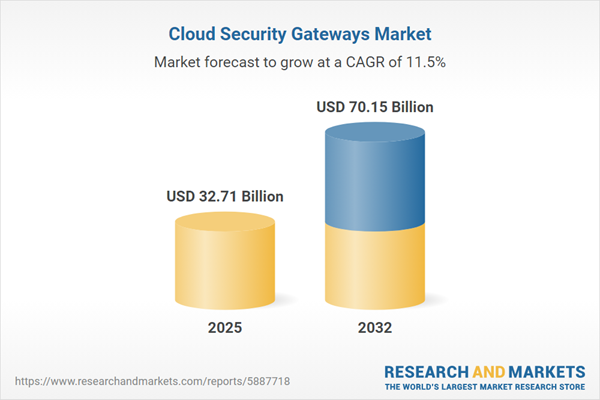Speak directly to the analyst to clarify any post sales queries you may have.
The Cloud Security Gateways Market is evolving in direct response to rapidly advancing cyber threats and the increasing complexity of cloud deployments. As organizations migrate workloads and data outside the traditional perimeter, modern cloud security gateways have become essential to maintaining control, transparency, and regulatory compliance within distributed digital environments.
Market Snapshot: Cloud Security Gateways Market
Fueled by accelerating cloud adoption and the mounting sophistication of cyberattacks, the cloud security gateways market demonstrates robust growth and continued innovation. With enterprises seeking to secure seamless connectivity, enforce unified policy controls, and manage diverse hybrid and multi-cloud architectures, the demand for integrated security solutions spans industries and regions. This market's expansion is supported by rising compliance demands, advanced threat detection technologies, and increased reliance on managed service models.
Scope & Segmentation: Comprehensive Analysis for Decision-Makers
- Deployment Modes: Cloud-Based, On-Premises
- Security Types: API Security (Gateway Security, Threat Protection), Data Security (Loss Prevention, Encryption), Email Security (Malware Detection, Phishing Protection, Spam Filtering), Mobile Security (App Security, MDM), Web Security (CASB, SWG)
- End-User Industries: Banking, Financial Services & Insurance, Energy & Utilities, Government, Healthcare, IT & Telecom, Manufacturing, Retail & Ecommerce
- Service Types: Hybrid Services, Managed Services, Professional Services
- Organization Sizes: Large Enterprises (Enterprise, Mid-Market), SMEs (Micro, Small & Medium)
- Regional Coverage: Americas (United States, Canada, Mexico, Brazil, Argentina, Chile, Colombia, Peru), Europe, Middle East & Africa (United Kingdom, Germany, France, Russia, Italy, Spain, Netherlands, Sweden, Poland, Switzerland, United Arab Emirates, Saudi Arabia, Qatar, Turkey, Israel, South Africa, Nigeria, Egypt, Kenya), Asia-Pacific (China, India, Japan, Australia, South Korea, Indonesia, Thailand, Malaysia, Singapore, Taiwan)
- Leading Companies: Zscaler, Inc., Microsoft Corporation, Cisco Systems, Inc., Netskope, Inc., Palo Alto Networks, Inc., Forcepoint, LLC, Broadcom Inc., Trellix LLC, Check Point Software Technologies Ltd., Bitglass, Inc.
Key Takeaways for Senior Leadership
- Cloud security gateways are critical for building unified and adaptive security postures across digital ecosystems, ensuring policy consistency and risk mitigation regardless of user location or device.
- Technology adoption is accelerating due to the need for real-time threat detection and predictive analytics, with artificial intelligence and machine learning now integral to effective anomaly identification and response.
- Segmented solution approaches offer organizations flexibility to address diverse requirements, from regulatory compliance in financial sectors to operational continuity in energy, utilities, and manufacturing environments.
- Collaboration between security, IT, and compliance teams helps organizations align technology investment with strategic business goals, ensuring continuous improvement against evolving threats.
- Vendor relationships and modular services support scalable, outcome-based deployments, enabling organizations to optimize resources and adapt rapidly as threat landscapes and business models evolve.
Tariff Impact: Navigating New Procurement Realities
Recent United States tariffs have heightened the complexity of hardware procurement, prompting a strategic shift toward cloud-native security models and flexible subscription plans. Vendors are adapting through supply chain diversification, local manufacturing, and managed service alliances, cushioning end users against tariff-driven cost fluctuations and supporting business continuity through hybrid and SaaS-based gateways.
Methodology & Data Sources
This report blends in-depth interviews with security architects and IT leaders, as well as secondary research from industry publications, regulatory frameworks, and real-world deployment case studies. Analytical modeling and triangulation ensure findings are both current and validated, providing industry stakeholders with accurate and actionable insights.
Why This Report Matters
- Empowers decision-makers to benchmark solution providers, anticipate market shifts, and assess strategic implications of regulatory change.
- Equips leaders with actionable recommendations for navigating hybrid deployments, regulatory pressures, and technology integration challenges.
- Delivers clarity on evolving market segmentation, supporting tailored investment and procurement strategies across diverse sectors.
Conclusion
Cloud security gateways now underpin digital resilience, policy consistency, and secure transformation. Leaders equipped with clear research and strategic guidance can optimize investments, fortify operations, and confidently advance digital agendas.
Additional Product Information:
- Purchase of this report includes 1 year online access with quarterly updates.
- This report can be updated on request. Please contact our Customer Experience team using the Ask a Question widget on our website.
Table of Contents
3. Executive Summary
4. Market Overview
7. Cumulative Impact of Artificial Intelligence 2025
Companies Mentioned
The companies profiled in this Cloud Security Gateways market report include:- Zscaler, Inc.
- Microsoft Corporation
- Cisco Systems, Inc.
- Netskope, Inc.
- Palo Alto Networks, Inc.
- Forcepoint, LLC
- Broadcom Inc.
- Trellix LLC
- Check Point Software Technologies Ltd.
- Bitglass, Inc.
Table Information
| Report Attribute | Details |
|---|---|
| No. of Pages | 199 |
| Published | October 2025 |
| Forecast Period | 2025 - 2032 |
| Estimated Market Value ( USD | $ 32.71 Billion |
| Forecasted Market Value ( USD | $ 70.15 Billion |
| Compound Annual Growth Rate | 11.5% |
| Regions Covered | Global |
| No. of Companies Mentioned | 11 |









